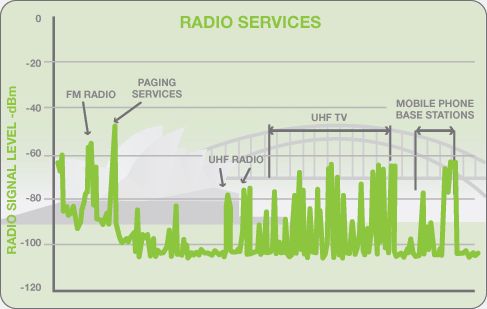Introduction
Radio communications are a part of everyday life in today's society. All radio communications systems utilise EMF in the radiofrequency (RF) part of the electromagnetic spectrum. Typical background EMF levels from radio communications systems are very low and well below safety guidelines.

What communications systems use radio frequency technology?
Radio frequency technology is used by
- TV and AM / FM broadcasts
- Mobile phones and their base stations
- Wireless broadband
- Radio paging services
- Cordless phones
- Baby monitors
- Emergency services communications (police, fire, ambulance)
- Air traffic control
How do the transmitter powers compare?
High powered systems are used for television and radio broadcast, usually from a single transmitting tower in an elevated location.
Medium powered systems are used for two-way communications typically from a repeater tower to vehicle radio systems like emergency services.
Low powered systems are used for mobile communications and rely on a network of transmitting sites like mobile phone base stations.
How strong are the environmental or background EMF levels in the community?
In a typical community, broadcast television and radio signals are similar in strength to signals from mobile phone networks and other two-way communications systems. These signals are overall very low and well below the established safety guidelines
The World Health Organisation has reviewed the background EMF levels from wireless systems and says,
"Recent surveys have shown that the RF exposures from base stations range from 0.002% to 2% of the levels of international exposure guidelines, depending on a variety of factors such as the proximity to the antenna and the surrounding environment. This is lower or comparable to RF exposures from radio or television broadcast transmitters"
Specifically on EMF levels in public areas, WHO says,
"Recent surveys have indicated that RF exposures from base stations and wireless technologies in publicly accessible areas (including schools and hospitals) are normally thousands of times below international standards."

Spectrum plot showing typical radio communications signals in a community
This picture is a plot from a spectrum analyser (specialised radio measurement equipment) showing the various radio communications signals measured in a typical community. The plot is taken at one location to illustrate typical radio communication signals present, and to make a comparison of signal level.
The type of radio service is indicated on the plot along horizontal axis and signal level in dBm (level relative to 1 milli-watt) on the left hand axis. The units are not really important here except to show relative levels. The picture also shows how many radio services are used in a typical community.
What research has been done on radio communications and EMF safety?
There has been a lot of research conducted worldwide to investigate possible health effects of radio communications and wireless technology.
In relation to radio frequency exposures and wireless technology and health, the general conclusion from the World Health Organization (WHO) is
"Despite extensive research, to date there is no evidence to conclude that exposure to low level electromagnetic fields is harmful to human health"
Summary of health Effects – Key point 6
http://www.who.int/peh-emf/about/WhatisEMF/en/index1.html
The WHO also says,
"radio and television broadcast stations have been in operation for the past 50 or more years without any adverse health consequence being established”
Electromagnetic Fields and public health – Fact sheet 304
Link
Download the Mobile Communications & Health Booklet from the GSMA











